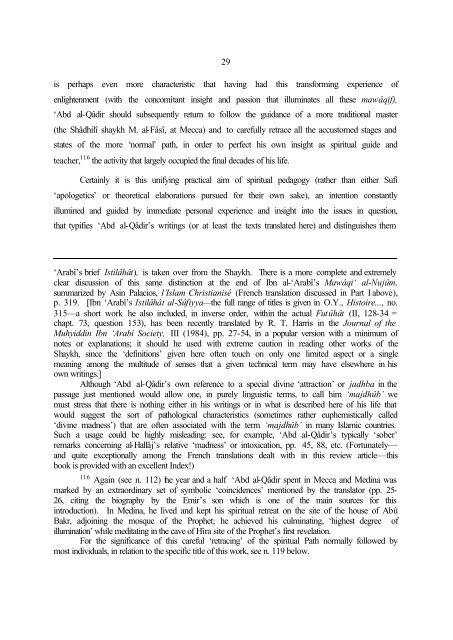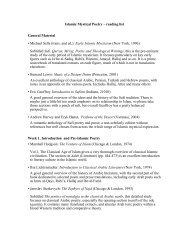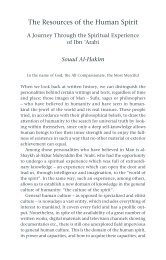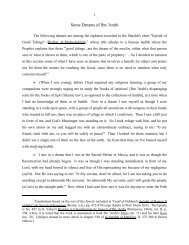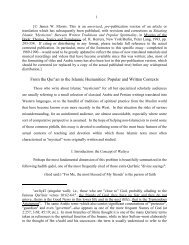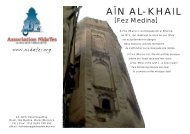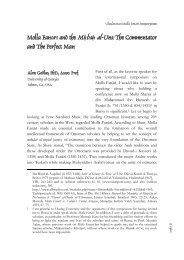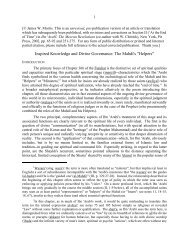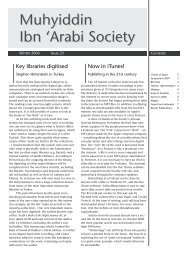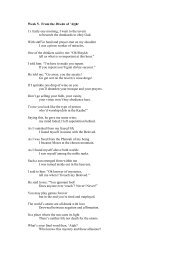Part III (pdf) - Muhyiddin Ibn Arabi Society
Part III (pdf) - Muhyiddin Ibn Arabi Society
Part III (pdf) - Muhyiddin Ibn Arabi Society
Create successful ePaper yourself
Turn your PDF publications into a flip-book with our unique Google optimized e-Paper software.
29is perhaps even more characteristic that having had this transforming experience ofenlightenment (with the concomitant insight and passion that illuminates all these mawâqif),‘Abd al-Qâdir should subsequently return to follow the guidance of a more traditional master(the Shâdhilî shaykh M. al-Fâsî, at Mecca) and to carefully retrace all the accustomed stages andstates of the more ‘normal’ path, in order to perfect his own insight as spiritual guide andteacher, 116 the activity that largely occupied the final decades of his life.Certainly it is this unifying practical aim of spiritual pedagogy (rather than either Sufi‘apologetics’ or theoretical elaborations pursued for their own sake), an intention constantlyillumined and guided by immediate personal experience and insight into the issues in question,that typifies ‘Abd al-Qâdir’s writings (or at least the texts translated here) and distinguishes them‘Arabî’s brief Istilâhât), is taken over from the Shaykh. There is a more complete and extremelyclear discussion of this same distinction at the end of <strong>Ibn</strong> al-‘Arabî’s Mawâqi‘ al-Nujûm,summarized by Asin Palacios, l’Islam Christianisé (French translation discussed in <strong>Part</strong> I above),p. 319. [<strong>Ibn</strong> ‘Arabî’s Istilâhât al-Sûfiyya—the full range of titles is given in O.Y., Histoire..., no.315—a short work he also included, in inverse order, within the actual Futûhât (II, 128-34 =chapt. 73, question 153), has been recently translated by R. T. Harris in the Journal of the<strong>Muhyiddin</strong> <strong>Ibn</strong> ‘Arabî <strong>Society</strong>, <strong>III</strong> (1984), pp. 27-54, in a popular version with a minimum ofnotes or explanations; it should he used with extreme caution in reading other works of theShaykh, since the ‘definitions’ given here often touch on only one limited aspect or a singlemeaning among the multitude of senses that a given technical term may have elsewhere in hisown writings.]Although ‘Abd al-Qâdir’s own reference to a special divine ‘attraction’ or jadhba in thepassage just mentioned would allow one, in purely linguistic terms, to call him ‘majdhûb’ wemust stress that there is nothing either in his writings or in what is described here of his life thatwould suggest the sort of pathological characteristics (sometimes rather euphemistically called‘divine madness’) that are often associated with the term ‘majdhûb’ in many Islamic countries.Such a usage could be highly misleading: see, for example, ‘Abd al-Qâdir’s typically ‘sober’remarks concerning al-Hallâj’s relative ‘madness’ or intoxication, pp. 45, 88, etc. (Fortunately—and quite exceptionally among the French translations dealt with in this review article—thisbook is provided with an excellent Index!)116Again (see n. 112) the year and a half ‘Abd al-Qâdir spent in Mecca and Medina wasmarked by an extraordinary set of symbolic ‘coincidences’ mentioned by the translator (pp. 25-26, citing the biography by the Emir’s son which is one of the main sources for thisintroduction). In Medina, he lived and kept his spiritual retreat on the site of the house of AbûBakr, adjoining the mosque of the Prophet; he achieved his culminating, ‘highest degree ofillumination’ while meditating in the cave of Hîra site of the Prophet’s first revelation.For the significance of this careful ‘retracing’ of the spiritual Path normally followed bymost individuals, in relation to the specific title of this work, see n. 119 below.


